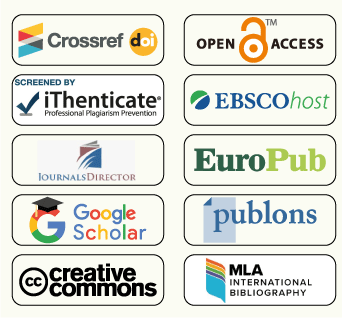The Representation of the two American candidates of the U.S. presidential elections 2016 in the world's newspapers: a critical discourse analysis
Abstract
The present study investigates the presentation of the two American candidates Donald Trump and Hillary Clinton in the presidential elections that occurred through the year 2016 in the world news. The study aims at examining how the Critical Discourse Analysis (CDA) tools together with cognitive semantics tools are applied to highlight the representation of both candidates throughout the period of the elections (2016). The study focuses on the framing technique as a tool of the cognitive semantics and highlights how the choice of words affects the idea of representing each candidate whether positively or negatively.
Keywords
Full Text:
PDFReferences
Biography, (2017a). Hillary Clinton Biography. Retrieved from http://www.biography.com/people/hillary-clinton-9251306
Biography, (2017b). Donald Trump Biography. Retrieved from http://www.biography.com/people/donald-trump-9511238
Elections (2016). In USA IN BRIEF. Retrieved from https://share.america.gov/wp-content/uploads/2016/04/Elections-USA_In-Brief-Series_English_Lo-Res.pdf
Evans, V. & Green, M. (2006). Cognitive Linguistics An Introduction. Edinburgh: Edinburgh University Press Ltd.
Fairclough, N & Wodak, R. (1997). Critical discourse analysis. In T. van Dijk (Ed.), Discourse Studies: A Multidisciplinary Introduction (Vol. 2, pp. 258-84). London: Sage.
Fillmore, C. (1982). Frame semantics. In Linguistic Society of Korea (Ed.), Linguistics in the Morning Calm pp. 111–37. Seoul: Hanshin Publishing.
Lakoff, G. (2005). Framing: It’s about values and ideas. In: www. Rockridgeinstitute.org/ (2005).
Lakoff, G. (2006). Thinking Points: Communicating our American values and vision. Clifornia: Macmillan.
Mellanen, H. (2012). "It's Barack Obama Who's Soft". Political Bias on BBC, CNN, and Fox News: A Critical Discourse Analysis of News Websites (Master's thesis). University of Turku.
Presidential Elections Process, 2017. In USA. gov. Retrieved from https://www.usa.gov/election#item-211441
Talmy, L. (2000). Towards a Cognitive Semantics (2 vols). Cambridge MA: MIT Press.
Thompson, J.B. (1990). Ideology and Modern Culture. Cambridge: Polity Press.
van Dijk, T. A. (1986). Racism in the Press. London: Arnold.
van Dijk, T. A. (1993). Elite Discourse and Racism. Newbury Park: Sage.
van Dijk, T. A. (1998). Ideology: A Multidisciplinary Approach. London: Sage.
van Dijk, T.A. (2001b). Multidisciplinary CDA: A plea for diversity. In M. Meyer & R. Wodak (Eds.), Methods of critical discourse analysis (pp.95-120). London: SAGE Publications Ltd.
Wodak, R. (2000). 'Does sociolinguistics need social theory? New perspectives on critical discourse analysis'. Keynote speech at SS 2000, Bristol, April 2000 (shortened and published in Discourse &Society, 2 (3): 123-147).
Wodak, R. (2001b). What CDA is about- a summary of its history, important concepts and its developments. In M. Meyer & R. Wodak (Eds.), Methods of critical discourse analysis (pp.1-13). London: SAGE Publications Ltd.
Wodak, R. (2006). Linguistic Analysis in Language Policies. In R. Thomas (Ed.). An Introduction to Language Policy (pp.170-193). USA: Blackwell Rublishing Ltd.
DOI: http://dx.doi.org/10.21622/ilcc.2022.02.1.001
Refbacks
- There are currently no refbacks.
Copyright (c) 2024 Donia Nagy Saeed Diab

This work is licensed under a Creative Commons Attribution-NonCommercial 4.0 International License.
Insights into Language, Culture and Communication
E-ISSN: 2812-491X
P-ISSN: 2812-4901
Published by:
Academy Publishing Center (APC)
Arab Academy for Science, Technology and Maritime Transport (AASTMT)
Alexandria, Egypt
ilcc@aast.edu

